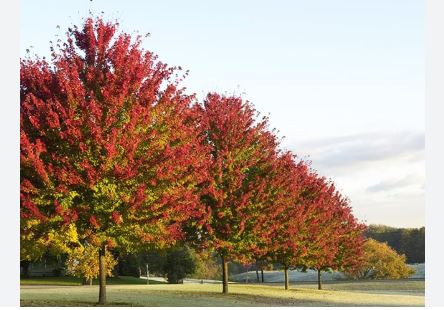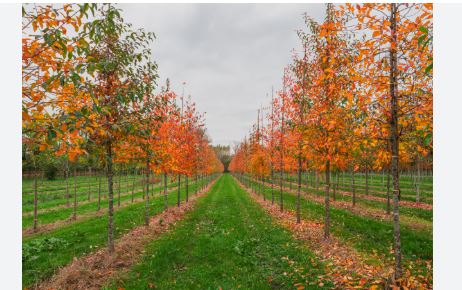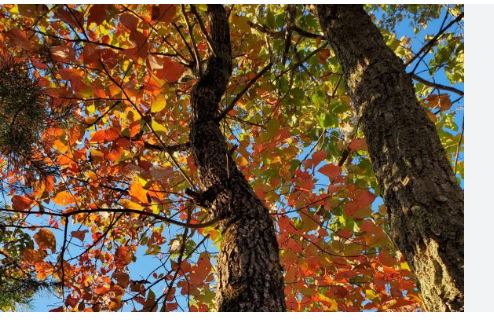
The Black Tupelo Tree (Nyssa sylvatica), also known as Black Gum or Sour Gum, is a striking deciduous tree native to North America, celebrated for its brilliant fall foliage, ecological value, and adaptability to diverse environments. Renowned for its glossy leaves, vibrant red autumn hues, and small, wildlife-friendly fruits, this medium-sized tree is a favorite in landscapes, urban settings, and naturalized areas.
Its deep cultural and ecological significance, combined with its resilience, makes it a standout species. In this detailed guide, we explore the botanical classification, history and native area, identifying characteristics, habitat, distribution, USDA hardiness zones, uses, and fascinating facts about the Black Tupelo Tree.
Botanical Classification, History and Native Area
The Black Tupelo Tree, scientifically named Nyssa sylvatica, belongs to the Nyssaceae family, a small family that includes tupelos and water tupelos. The genus Nyssa, named after a Greek water nymph, comprises about 8–10 species, primarily in North America and Asia. The species name sylvatica, meaning “of the woods” in Latin, reflects its forest habitat.
As an angiosperm, it produces flowers and seeds, with a typically dioecious reproductive system, featuring separate male and female trees, though some are monoecious. Its taxonomic relatives include the Water Tupelo (Nyssa aquatica) and Ogeechee Tupelo (Nyssa ogeche), but N. sylvatica is distinguished by its upland adaptability and brilliant fall color, setting it apart from wetland-focused relatives.
The Black Tupelo is native to eastern North America, with a history stretching back millions of years, as evidenced by fossil records from the Miocene epoch. Its range spans from southern Ontario and Maine to Florida, west to Texas, and north to Michigan, thriving in diverse ecosystems from swamps to dry uplands.
Indigenous peoples, such as the Cherokee and Creek, used its wood for tools, its bark for medicinal teas, and its sour fruits in culinary preparations, embedding it in cultural practices. European settlers adopted it for timber and ornamental planting, noting its durability and beauty. Today, it is valued for ecological restoration and landscaping, though habitat loss and urban sprawl threaten some native stands, highlighting its conservation importance.
Identifying Characteristics

The Black Tupelo is a medium-sized deciduous tree, typically growing 30–50 feet (9–15 meters) tall, with some specimens reaching 80–100 feet (24–30 meters) in optimal conditions, and a spread of 20–30 feet. Its canopy is oval to pyramidal, with horizontal branches creating a tiered appearance. The bark is dark gray to brown, deeply furrowed, and blocky, resembling alligator hide on mature trees.
Leaves are alternate, simple, and ovate to elliptical (3–6 inches long), glossy dark green above, paler below, turning brilliant shades of red, orange, yellow, or purple in fall, often among the earliest trees to color. The tree produces small, greenish-white flowers in spring, followed by small, blue-black drupes (0.5 inches) on female trees, edible but sour. Twigs are reddish-brown, with small, pointed buds, and the tree’s straight trunk and lustrous foliage enhance its ornamental appeal.
Habitat
The Black Tupelo is highly adaptable, thriving in a range of habitats from lowland swamps and floodplains to dry upland forests and rocky slopes. It prefers moist, well-drained, acidic soils (pH 4.5–6.5), typically loamy or sandy, but tolerates clay, wet, or moderately dry conditions. It grows best in full sun to partial shade, requiring at least 4–6 hours of sunlight for optimal foliage color and fruit production.
In its native range, it grows alongside oaks, pines, and hickories, often in mixed hardwood forests or wetland edges, where its deep taproot stabilizes soils. In cultivation, it adapts to urban parks, gardens, and streetscapes, tolerating pollution and compacted soils but requiring protection from salt and mechanical damage to its bark. Its versatility makes it a valuable species for diverse landscapes.
Distribution
The Black Tupelo is widely distributed across eastern North America, from southern Ontario and Quebec to central Florida, west to eastern Texas, and north to Wisconsin and Michigan, with its core range in the Appalachian Mountains, Mississippi Valley, and Atlantic Coastal Plain. It is a dominant species in both wetland and upland forests, particularly in the southeastern U.S.
Introduced to cultivation in Europe, Australia, and parts of Asia, it is planted as an ornamental for its fall color and resilience. In the U.S., it is popular in states like Virginia, Georgia, and Illinois, available through nurseries like FastGrowingTrees.com and NatureHills.com. It can naturalize in moist, disturbed sites but is not considered invasive, as its seed dispersal is primarily wildlife-dependent, ensuring ecological balance.
USDA Hardiness Zones
The Black Tupelo thrives in USDA Hardiness Zones 3–9, tolerating minimum temperatures from -40°F to 20°F (-40°C to -7°C). It excels in a wide range of climates, from cold northern winters to hot, humid southern summers, making it one of the most adaptable North American trees.
In Zone 3, it withstands extreme cold with mulching and wind protection, while in Zone 9, it tolerates heat and humidity with irrigation and partial shade to prevent leaf scorch. Its broad hardiness range supports its use in diverse landscapes, from rural woodlands to urban streets, provided soil and moisture needs are met, ensuring vibrant fall displays and robust growth.
Uses
The Black Tupelo is a multifaceted tree with ornamental, ecological, and practical applications. Its brilliant fall foliage, ranging from fiery red to deep purple, makes it a premier ornamental for gardens, parks, streetscapes, and campuses, where its compact size and tiered canopy add aesthetic value.
Ecologically, its flowers attract pollinators like bees, and its sour drupes are a vital food source for birds (e.g., robins, woodpeckers) and mammals (e.g., deer, bears), supporting biodiversity. The tree’s deep taproot stabilizes soils in wetlands and uplands, aiding erosion control and stormwater management in rain gardens.
Its wood, dense and resistant to splitting, is used for furniture, crates, pallets, and pulp, though harvesting is limited due to its ecological value. In urban settings, it provides shade, sequesters carbon, and improves air quality, though its dioecious nature requires planting both genders for fruit production if desired. Culturally, it is a symbol of resilience in North American landscapes.
Fun Facts
The Black Tupelo is steeped in captivating facts that underscore its unique character. Its fall foliage, often turning red as early as September, is one of the earliest and most vivid among North American trees, rivaling maples in brilliance. The sour drupes, nicknamed “tupelo plums,” were used by Indigenous tribes to make preserves and beverages, despite their tart flavor.
Its blocky, alligator-like bark inspired the nickname “alligator wood” among lumbermen. A Black Tupelo in Arkansas, estimated at over 500 years old, is one of the oldest known specimens, showcasing its longevity. The tree’s honey, produced from its nectar in the Southeast, is prized as “tupelo honey,” celebrated in song and cuisine.
Its deep taproot, often twice the tree’s height, makes transplanting mature trees challenging but ensures stability. Finally, its dioecious nature means only female trees bear fruit, adding an element of surprise to seedling plantings.
Cultivation of Black Tupelo Tree (Nyssa sylvatica)

Cultivating the Black Tupelo Tree (Nyssa sylvatica), also known as Black Gum or Sour Gum, is a rewarding endeavor for gardeners, landscapers, and conservationists seeking a resilient, medium-sized deciduous tree with brilliant red fall foliage, wildlife-friendly fruits, and adaptability to diverse conditions. Native to eastern North America, this tree enhances urban parks, rural landscapes, and rain gardens with its ecological and ornamental value, but it requires careful management due to its deep taproot, dioecious nature, and sensitivity to transplanting.
- Climate Suitability: Black Tupelo thrives in USDA Hardiness Zones 3–9, tolerating minimum temperatures from -40°F to 20°F (-40°C to -7°C). It excels in a wide range of climates, from cold northern winters to hot, humid southern summers. In Zone 9, provide irrigation and partial shade during extreme heat to prevent leaf scorch, while in Zone 3, protect young trees from harsh winds to ensure survival.
- Site Selection: Choose a location with full sun to partial shade, receiving at least 4–6 hours of direct sunlight daily, to promote vibrant fall color and fruit production. Full sun maximizes foliage intensity, though light shade is tolerated in hotter climates. Ensure the site accommodates its mature size (30–50 feet tall, 20–30 feet wide) and avoid planting near pavement, as its deep taproot may cause minor uplift in confined spaces.
- Soil Requirements: Plant in moist, well-drained, acidic soil with a pH of 4.5–6.5, preferably loamy or sandy, to support healthy growth and coloration. The tree tolerates clay, wet, or moderately dry soils but is sensitive to waterlogged conditions, which cause root rot. Test soil drainage and amend with organic matter (e.g., compost, peat moss) to enhance fertility, aeration, and moisture retention without saturation.
- Planting Time: The optimal planting seasons are early spring or fall, allowing roots to establish before summer heat or winter cold. Use young, container-grown or balled-and-burlapped trees, as mature trees with deep taproots transplant poorly. Dig a hole twice as wide and as deep as the root ball, positioning the root collar at ground level. Backfill with a mix of native soil and compost, tamp gently, and water deeply to settle the roots.
- Watering Needs: Water young trees deeply (1–2 times weekly) for the first 1–2 years to establish a deep taproot, keeping soil consistently moist but not soggy. Once established, the tree is highly adaptable, tolerating periodic flooding and moderate drought, but benefits from supplemental watering during prolonged dry spells, especially in warmer zones or urban settings, to maintain foliage health and fall color vibrancy.
- Mulching: Apply a 2–4 inch layer of organic mulch (e.g., shredded bark, wood chips) around the base, extending to the drip line but keeping it 2–4 inches from the trunk to prevent rot and pest issues. Mulch conserves moisture, regulates soil temperature, and protects the taproot, supporting young trees in gardens or streetscapes. Replenish mulch annually to maintain its benefits.
- Fertilization: Fertilize young trees in early spring with a balanced, slow-release fertilizer (e.g., 10-10-10 or 5-10-5) formulated for acid-loving plants, applying at half the recommended rate to promote steady growth without excessive foliage that weakens structure. Mature trees need minimal fertilization in fertile soils, but a light application every 2–3 years can enhance color and vigor. Avoid high-nitrogen fertilizers, which may reduce fall coloration.
- Pruning: Prune in late winter or early spring, when the tree is dormant, to remove dead, damaged, or crossing branches and to shape its pyramidal canopy, using clean, sharp tools to prevent disease spread. Light pruning enhances airflow and light penetration, critical for foliage health, but avoid heavy cuts, as tupelos are slow to heal and susceptible to fungal infections. Remove lower branches gradually for street trees to ensure clearance.
- Pest and Disease Management: Monitor for pests like scale, aphids, or tupelo leaf miners, treating infestations with insecticidal soap or neem oil. The tree is relatively pest-resistant but susceptible to fungal diseases such as leaf spot, canker, or verticillium wilt in wet or poorly drained conditions; ensure good drainage, improve air circulation, and remove infected debris promptly. Apply fungicides preventatively in high-risk areas, and avoid wounding the bark to minimize infection risks.
- Spacing: Space trees 20–30 feet apart to accommodate their mature canopy spread, ensuring adequate sunlight and air circulation to promote foliage health and reduce disease risk. For group plantings or naturalized areas, plant 15–20 feet apart for a cohesive canopy. Consider their height (up to 50 feet, rarely 100 feet) when planning near structures, power lines, or pathways to avoid conflicts with branches or roots.
- Wind Protection: Young Black Tupelos, with deep taproots, are wind-tolerant but may need support in exposed sites to prevent leaning during establishment. Stake newly planted trees for the first 1–2 years using flexible ties to allow slight trunk movement, strengthening roots. Remove stakes once established to prevent girdling. Plant in sheltered locations or use windbreaks (e.g., shrubs, fences) in windy areas to protect foliage.
- Winter Care: In Zone 3, protect young trees from winter damage by wrapping trunks with burlap or tree guards to prevent sunscald, frost cracks, and rodent damage, and mulching heavily (4–6 inches) around the base to insulate roots. Water adequately before freeze-up to prevent dehydration, as deciduous trees lose moisture in winter. Mature trees are highly cold-hardy and require minimal winter care, but monitor for deer browsing in rural areas.
- Long-Term Growth: Black Tupelo Trees grow moderately slowly (1–2 feet per year), reaching 30–50 feet at maturity, with lifespans of 100–500 years in optimal conditions, among the longest-lived hardwoods. Their brilliant fall foliage, wildlife-friendly fruits, and tiered canopy make them ideal for ornamental landscapes, urban parks, or ecological restoration. Regular monitoring for pests, diseases, and bark damage, combined with attentive care, ensures lasting beauty and ecological contributions.